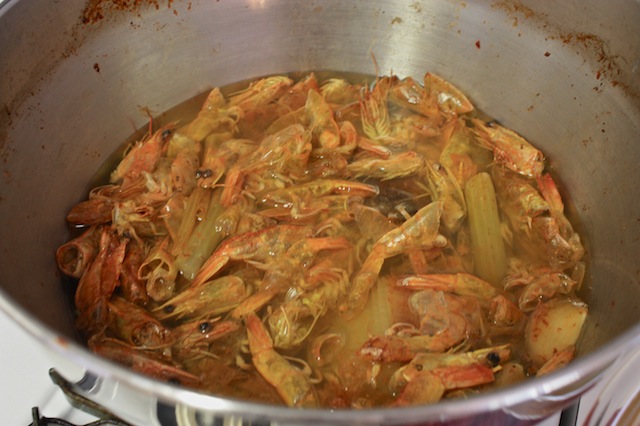
Homemade Seafood Stock
If you’ve ever wondered what sets New Orleans food apart from the rest of the world, it’s the layers of flavor that go into each dish. Two of the most important layers are the roux and the stock. I’ve already posted a bunch about the roux which you can read here:
Now for the stock. This is yet another back-to-basics cooking skill worth the effort.
Making stock from scratch is easy, it just takes a little time. It’s best to plan ahead so you’ll always have a stash of seafood, chicken and beef stock tucked away in the freezer. I’ve gotten into the habit of saving shells and bones from other recipe preparations and freezing them in separate containers. Once I’ve collected enough of each, I set aside a weekend morning to make stock. For seafood stock I like to use shrimp shells and heads because they’re the most convenient, but the shells and bones of any mild-flavored shellfish or non-oily fish will do. My chicken stock is generally made with a combination of wing tips (that I snip off and save when making Buffalo chicken wings), necks and the leftover carcass from a roasted or rotisserie chicken. My beef stock is based on meaty soup bones that I get from the grocery store.
I totally get that you don’t always have time to make a homemade stock and neither do I. So when time is limited and your stash is depleted, go for the store-bought varieties. Just remember that when you’re looking to capture the true essence of a dish, there’s no substitute for homemade stock.
Seafood Stock
2 tablespoons canola oil
3 pounds shrimp heads and shells, crawfish heads and shells and/or blue crab shells
1 large onion, coarsely chopped
1 stalk celery, coarsely chopped
1 carrot, coarsely chopped
2 garlic cloves, crushed
3 bay leaves
1 gallon cold water
In a large stockpot over medium-high heat, heat oil. Add the heads and/or shells and mash with a potato masher (to release more flavor). Add onions, celery, carrots and garlic. Cook, stirring frequently, until tender, 3-5 minutes. Add bay leaves and water. Increase heat to high and bring to a boil. Reduce heat to low and simmer, uncovered, until reduced by half, about 2 hours. Occasionally check stock and skim any foam that rises to the surface. Strain through a colander and discard solids. Cool, cover and refrigerate for up to 3 days or freeze in small batches for later use. Makes about 2 quarts.
Chicken Stock
2 tablespoons canola oil
1 large onion, halved
1 celery stalk, halved
1 carrot stick, halved
2 garlic cloves, smashed
2 pounds chicken carcass and bones
3 bay leaves
1 gallon cold water
In a large stockpot over medium-high heat, heat oil. Add onions, celery, carrots and garlic. Cook, stirring frequently, until tender, 3-5 minutes. Add chicken carcass and bones, bay leaves and water. Increase heat to high and bring to a boil. Reduce heat to low and simmer, uncovered, until reduced by half, about 2 hours. Occasionally check stock and skim any foam or fat that rises to the surface. Strain through a colander and discard solids. Cool, cover and refrigerate for up to 3 days or freeze in small batches for later use. Makes about 2 quarts.
Beef or Veal Stock
2 pounds meaty beef and/or veal bones
1 large onion, halved
1 celery stalk, halved
1 carrot stick, halved
2 garlic cloves, smashed
3 bay leaves
1 gallon cold water, divided
Preheat oven to 400 degrees. Place bones in roasting pan and bake until golden brown, about 20 minutes, turning once. Place onions, celery, carrots and garlic over the bones, return to oven and roast an additional 20 minutes. Transfer bones and vegetables to a large stockpot. Deglaze roasting pan by placing pan over two burners. Add 2 cups water to pan. Cook over medium-high heat for about 3-5 minutes, scraping up all the brown bits from pan. Add pan drippings, bay leaves and water to stockpot; bring to a boil. Reduce heat to simmer and cook, uncovered, until reduced by half, about 2 hours. Occasionally check stock and skim any foam or fat that rises to the surface. Strain through a colander and discard solids. Cool, cover and refrigerate for up to 3 days or freeze in small batches for later use. Makes about 2 quarts.
Like I said, you’re not going to find any recipe easier than this so find the time to make your own stock and taste the difference in your meals!
Genêt



